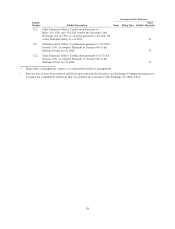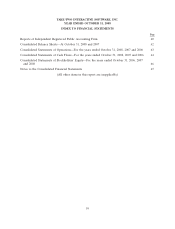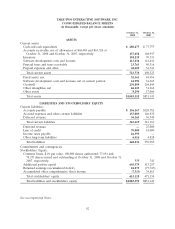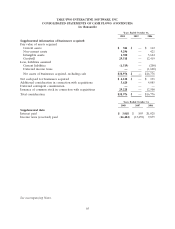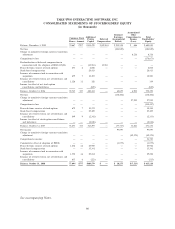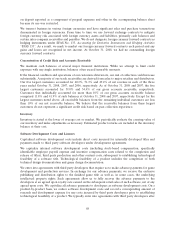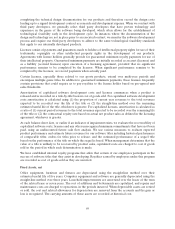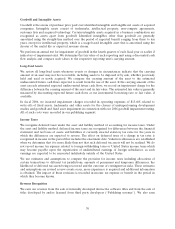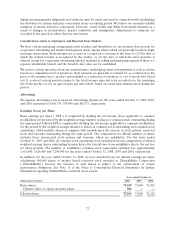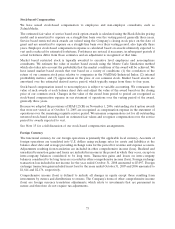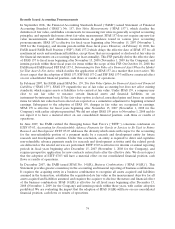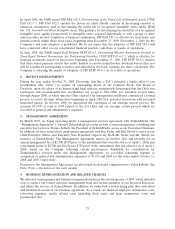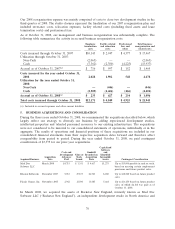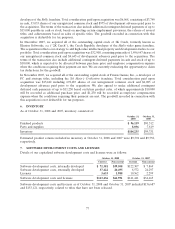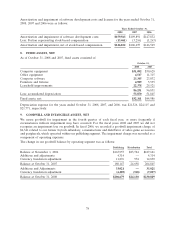2K Sports 2008 Annual Report Download - page 78
Download and view the complete annual report
Please find page 78 of the 2008 2K Sports annual report below. You can navigate through the pages in the report by either clicking on the pages listed below, or by using the keyword search tool below to find specific information within the annual report.on deposit reported as a component of prepaid expenses and other in the accompanying balance sheet
because its use was restricted.
We transact business in various foreign currencies and have significant sales and purchase transactions
denominated in foreign currencies. From time to time, we use forward exchange contracts to mitigate
foreign currency risk associated with foreign currency assets and liabilities, primarily cash balances and
certain inter-company receivables and payables. We do not designate foreign currency forward contracts as
hedging instruments under SFAS No. 133, Accounting for Derivative Instruments and Hedging Activities
‘‘SFAS 133’’. As a result, we mark to market our foreign currency forward contracts each period and any
gains and losses are recognized in net income. At October 31, 2008, we had no outstanding foreign
currency forward contracts.
Concentration of Credit Risk and Accounts Receivable
We maintain cash balances at several major financial institutions. While we attempt to limit credit
exposure with any single institution, balances often exceed insurable amounts.
If the financial condition and operations of our customers deteriorate, our risk of collection could increase
substantially. A majority of our trade receivables are derived from sales to major retailers and distributors.
Our five largest customers accounted for 40.2%, 51.1% and 49.4% of net revenue in each of the three
years ended October 31, 2008, 2007, and 2006, respectively. As of October 31, 2008 and 2007, the five
largest customers accounted for 39.0% and 54.4% of our gross accounts receivable, respectively.
Customers that individually accounted for more than 10% of our gross accounts receivable balance
comprised 11.8% and 41.9% of such balances at October 31, 2008 and 2007, respectively. Except for the
largest customers noted above, all receivable balances from the remaining individual customers are less
than 10% of our net receivable balance. We believe that the receivable balances from these largest
customers do not represent a significant credit risk based on past collection experience.
Inventory
Inventory is stated at the lower of average cost or market. We periodically evaluate the carrying value of
our inventory and make adjustments as necessary. Estimated product returns are included in the inventory
balance at their cost.
Software Development Costs and Licenses
Capitalized software development costs include direct costs incurred for internally developed titles and
payments made to third party software developers under development agreements.
We capitalize internal software development costs (including stock-based compensation, specifically
identifiable employee payroll expense and incentive compensation costs related to the completion and
release of titles), third party production and other content costs, subsequent to establishing technological
feasibility of a software title. Technological feasibility of a product includes the completion of both
technical design documentation and game design documentation.
We enter into agreements with third party developers that require us to make advance payments for game
development and production services. In exchange for our advance payments, we receive the exclusive
publishing and distribution rights to the finished game title as well as, in some cases, the underlying
intellectual property rights. Such agreements allow us to fully recover the advance payments to the
developers at an agreed upon royalty rate earned on the subsequent retail sales of such software, net of any
agreed upon costs. We capitalize all advance payments to developers as software development costs. On a
product-by-product basis, we reduce software development costs and record a corresponding amount of
research and development expense for any costs incurred by third party developers prior to establishing
technological feasibility of a product. We typically enter into agreements with third party developers after
68


